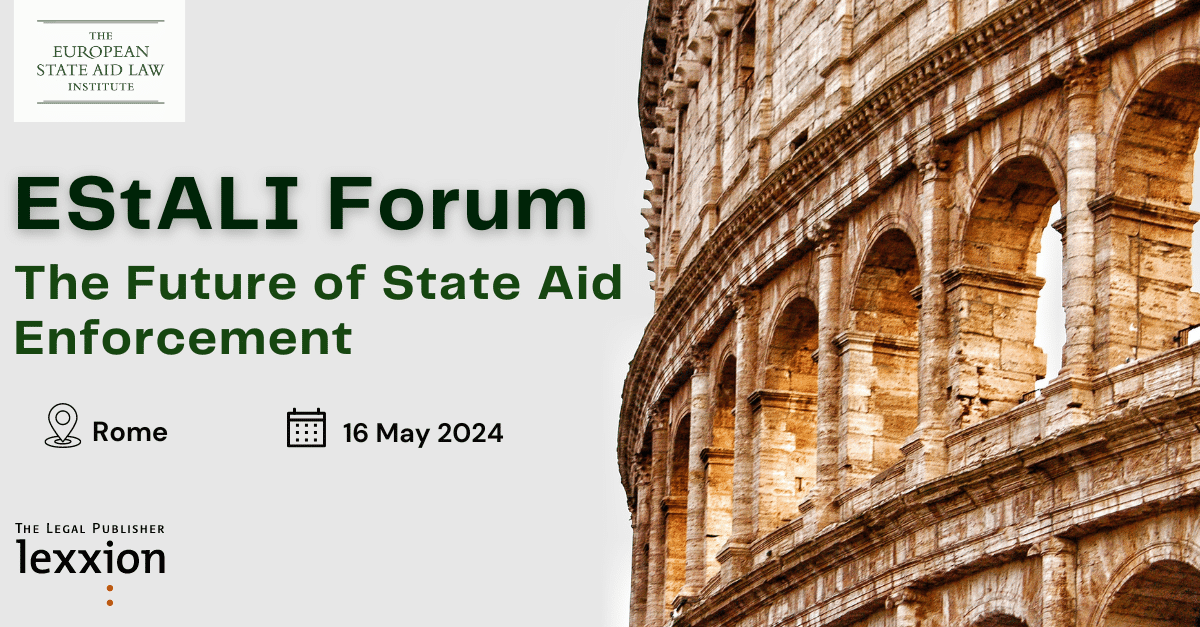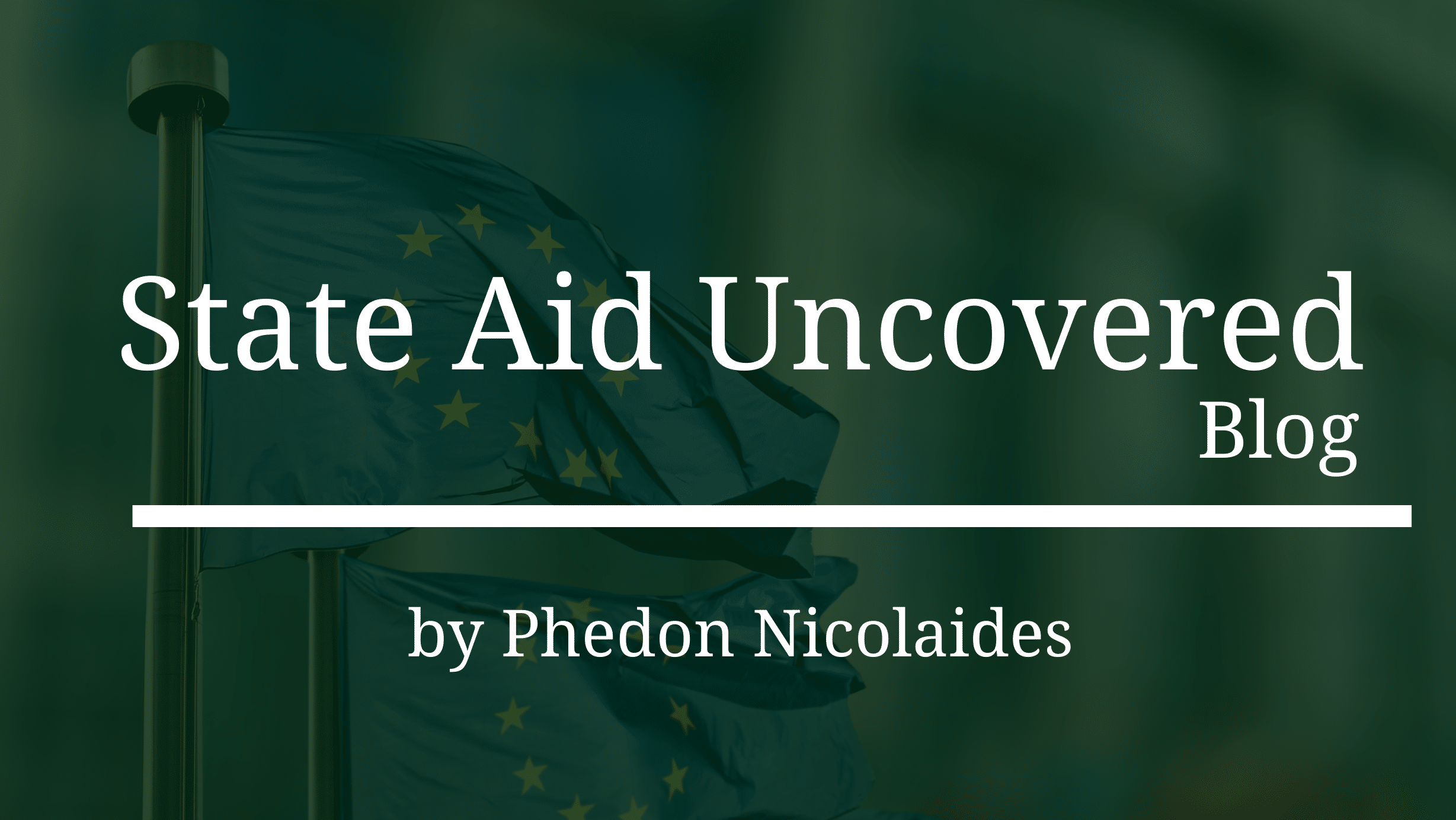Quality statement and general terms of publication
EStAL accepts submissions of excellent quality only. Responsibility of the factual accuracy of a paper rests entirely with the author. All publications must clearly distinguish themselves from the status quo of discussions among the informed State aid community – in particular through sufficiently broad referencing (as footnotes) – and provide an added value to those discussions. Contributions should not have been published, nor be pending publication elsewhere.
Whereas opinions and case notes may be more factual and focused, articles must rely on pre-existing literature and jurisprudence, even if the positions expressed there are to be contradicted. Likewise, submissions relating to very recent developments require less referencing than submissions relating to more established topics. Publications not up to this quality standard will be rejected.
Submission of a manuscript does not imply claim for publication. Optionally before submitting a manuscript, the editors may be contacted regarding the suitability of a given topic for EStAL.
The manuscript must also be complete and final in terms of formulation and factual information so that no major corrections – only of type-setting errors or the like – will be necessary after type-setting, when an edited version (the galley proof) will be returned to the author for final checking. Subsequent requests for corrections cannot be processed.
Review Process
All articles submitted to EStAL are subject to its double-blind peer-review process and evaluated for accuracy, quality, novelty and relevance. The peer-review process is an essential and integral part of research and publication, at the same time helping authors improve their work and serving as quality check for the community as a whole.
Articles are first assessed for general fitness to the scope of the journal and overall quality by an Editorial Board member. If deemed to be of sufficient interest it is then sent for external peer-review by a recognized expert in the topic covered by the article.
Articles may be rejected, accepted pending minor or major modifications, or accepted as is. The latter is extremely rare; authors are hereby advised that the vast majority of papers must be adapted to some extent before being accepted for publication on EStAL. All authors, regardless of position, origin or status, are expected to respect the comments and suggestions of reviewers and those of the Editorial Team.
Contributions other than Articles (Case Notes, Opinions, News from the Member States and Book Reviews) may follow a simplified peer-review process, either single-blind or open.
Format and Style
EStAL’s official referencing and style guide is OSCOLA 4th edition, supplemented by the points in this Guideline.
All contributions must comply with the formatting requirements laid out hereunder. Contributions not respecting these formatting and style requirements will be returned to the author.
Format and length
Articles should not be longer than 8000 words including footnotes. Longer articles may be accepted on a case-by-case basis if more space is justified by the topic.
Case annotations should not be longer than 4000 words including footnotes.
Shorter contributions between 2000 and 4000 words including footnotes, may take the form of Opinions on current issues of interest. These should include no or only very few footnotes.
News from the Member States should not be longer than 2000 words including footnotes.
Book reviews should be around 1500 words in length, with minimal to no footnote references.
All submissions should be in MS Word format, single column, Times New Roman, font size 12, line spacing 1 ½.
Abstract and keywords
Each article must be preceded by a short abstract (without heading) in italics of five to six sentences, without footnotes (approx. 200 words).
3-5 relevant, specific keywords should be added, separated by semi-colons. Avoid generic terms such as merely ‘State aid’ or ‘EU law’.
Presentation
Title
Every word of the Title should be capitalised except for conjunctions (Headline Capitalisation). The Title’s length should not exceed three lines after typeset (max. 100 characters including spaces).
Subtitles are allowed and should not exceed the 3 lines rule either (max. 100 characters including spaces).
Authors’ details
Author details should be included in a first asterisk footnote (*) inserted after the author’s/authors name.
Example:
Article Title
Christopher Bovis*
…….
* Prof Dr Christopher Bovis FRSA, H K Bevan Chair in Law, Law School, University of Hull; Managing Editor of the European Procurement and Public Private Partnership Law Review (EPPPL). For correspondence: <epppl@lexxion.eu>.
To do so: In the References ribbon tab, click the Footnotes launcher (lower right corner in the Footnotes section). There, place an asterisk into the Custom mark: box, then click Insert, and type your footnote text.
All further footnotes should be numbered sequentially in superscript in the text outside punctuation marks.
Tables and figures
All figures must be sent in separate graphics files (.jpg, .png etc.), in high resolution and in greyscale (publication in colour is not possible).
Tables and figures should not be longer than half a page each. If longer ones are absolutely necessary, they should be treated as annexes and included in separate pages at the end of the article.
Every table and figure should have a title. The relevant sources of the data presented or of the tables or figures themselves should be indicated. Within the text, the position at which a table is to be included should be marked by ‘[TABLE X…]’, the tables and figures being clearly numbered. Every table and figure should be referred to.
Please do not use boxes.
To ease the typesetting process, please keep formatting within tables to a minimum (eg avoid merged cells or the use of vertical text for headings).
Section and Sub-section Headings
The headings of (sub-)sections should be structured as follows:
H1: I. (Roman numerals in Capital, starting with the Introduction)
H2: 1. (Arabic numerals)
H3: a. (Minuscule letters)
H4: i. (Minuscule Roman numerals)
Quotation and referencing
All references should be included in the footnotes: no final bibliographies are allowed. In-text citations of the form Kelsen(1967) should not be used either.
All references must be presented in the official reference style, OSCOLA. For CJEU Cases and European Commission Decisions and documents, use preferably the forms given below instead.
Full guide: http://www.law.ox.ac.uk/published/OSCOLA_4th_edn.pdf
Footnotes
Footnotes should be reserved for referencing and short comments only. A footnote may not in any event be longer than 100 words.
Longer comments, even if ancillary or digressive, should be incorporated into the body of the text or omitted.
Use only the automatic footnote function in MS Word. Note that footnote references should be placed outside punctuation marks.
Do not use linked cross-references (clickable links in the footnote, to other footnotes) as these cause technical problems in typesetting.
CJEU judgments
Case reference | short name | [Court collections year] volume and page | [paragraph number]
or
Case reference | short name | [year] ECLI number | [paragraph number]
Case C–280/00 Altmark [2003] ECR I-7747 [88-90].
Case C-579/16 P FIH Holding [2018] ECLI:EU:C:2018:159.
Case E-12/11 Konkurrenten.no AS [2011] EFTA Ct. Rep. 266.
Case short names are in italics. For judgments not yet registered in the Court collections, the date of judgment is to be given and an indication that the judgment is not yet reported (n.y.r.).
Joined Cases T-80/06 and T-182/09 Budapest Erőmű judgment of 13.02.2012, not yet reported [57].
Opinion of Advocates-General
Opinion of AG | AG last name | Date of Opinion | in Case number | Case short name | [year] | Case reference or ECLI | [paragraph/s number].
Opinion of AG Szpunar of 28.11.2017 in Case C-579/16 P FIH Holding [2017] ECLI:EU:C:2017:911 [68].
Opinion of AG Sharpston of 03.03.2009 in Case C-319/07 P 3F [2009] ECR I-05963 [16].
Commission Decisions
European Commission Decision | act number | of | date | concerning/on | SA Case number | act name | (OJ or Institutional Reference) | page number.
European Commission Decision (EU) 2015/658 of 8 October 2014 on the aid measure SA.34947 (2013/C) (ex 2013/N) which the United Kingdom is planning to implement for support to the Hinkley Point C nuclear power station (OJ 2015 L 109) 44.
European Commission Decision 2000/513/EC of 8 September 1999 on aid granted by France to Stardust Marine (OJ 2000 L 206) 6.
Journal Articles
Indicate the year of publication in square brackets if it identifies the volume, in round brackets if there is a separate volume number;
author, | ‘title’ | [year] | journal name or abbreviation | first page of article
author, | ‘title’ | (year) | volume | issue | journal name or abbreviation | first page of article
M Martens and S de Margerie, ‘The Link to the Subject-Matter of the Contract in Green and Social Procurement’ (2013) 8 European Procurement and Public Private Partnership 8.
Where a specific page is being referenced, pinpoint this with a comma after the starting page of the article
author, | ‘title’ | (year) | volume | issue | journal name or abbreviation | first page of article |, pinpoint reference.
M Martens and S de Margerie, ‘The Link to the Subject-Matter of the Contract in Green and Social Procurement’ (2013) 8 European Procurement and Public Private Partnership 8, 14.
Books
author, | title | (additional information, | edition, | publisher | year), | page number
M Schmauch, EU Law on State Aid to Airlines (Lexxion 2012).
Book chapters
author, | ‘title’ | in editor (ed), | book title | (additional information,| publisher | year), pinpointed page.
S Nespor, ‘Global Warming: the Death of Environmentalism?’ in T Ormond, M Führ and R Barth (eds), Environmental Law and Policy at the Turn of the 21st century (Lexxion 2006), 187.
Note that where a specific page is being referenced, this is pinpointed with a comma after the publication information but that p. or pp. are not used.
Cross-referencing
Cross-referencing should follow the following format:
short reference | (n footnote number) | page number or [paragraph number].
Fluck and Wintterle (n 45).
Altmark (n 2) [62].
Only include page or paragraph number if different from the original citation.
‘ibid’ should only refer to immediately preceding references.
Electronic sources
Always indicate the last date an electronic source is known to be reliable. It is recommended to check all urls before submission, and include a note to this effect with the date as the first footnote:
1 All websites accessed 31 February 2015.
Alternatively, follow each url with the date of most recent access, expressed in the form ‘accessed 1 January 2010’.
Always include ‘http://’ or ‘https://’.
Citations of publications that are available only electronically should end with the web address (or ‘url’) within angled brackets (< >). Avoid urls that are overly long, or use an url shortener.
Do not cite a temporary electronic source.
Abbreviations and Style Points
In the body of the text abbreviations should generally be avoided. Common Latin abbreviations may be used, but note that OSCOLA does not use periods nor italics: eg, ie, etc, et seq, et al…
Abbreviations should be introduced simply between parenthesis after the first use of the term, eg: Court of Justice of the European Union (CJEU). Do not add quotation marks, boldface, or terms such as ‘hereinafter’.
References to judgment names should be in italics, eg Altmark and PreussenElektra. Note however that it should be ‘the Altmark conditions’!
Style points :
- State aid (not State Aid or state aid)
- ‘%’ instead of ‘per cent’
- ‘$’, ‘€’, ‘£’ instead of ‘Dollar’, ‘Euro’ or ‘EUR’, ‘Pound’ etc.
- ‘Judgment’ instead of ‘Judgement’
- ‘Article’ (not, Arts etc)
Common terms and usage
The word ‘Decision’ should always be capitalised when referring to such legal acts of the European Union; same for ‘Directive’ and ‘Regulation’.
Use ‘Court of Justice’ or ‘CJ’ (when referring to the appellate body) and ‘Court of Justice of the European Union’ or ‘CJEU’ when referring to the Curia as a whole. The terms ‘European Court of Justice’ and ‘ECJ’ are outdated/apocryphal and should not be used.
Avoid variational terms such as ‘the Court in Luxembourg’. Note also that ‘the Court of Luxembourg’ would refer to a national Luxembourgish judicial body.
Do not use gendered pronouns for non-natural persons: ‘the European Union itself’, ‘market operators themselves’ etc. Never ‘himself’, ‘herself’… The form ‘him or herself’ is cumbersome: prefer to use the plural neutral: ‘clients themselves are unaware that…’; ‘victims have a right to their just compensation.’
The preferred title for a legal professional called to the bar or member of an order is Lawyer. Attorney is also accepted. The title ‘Attorney-at-law’ only officially exists in the United States of America, Canada and certain other jurisdictions. Legal professionals not called to the bar in those jurisdictions should avoid it. Their own national titles (Avocat, Rechsanwältin, Advocaat etc…) can also be used. Do not use ‘variants’ such as ‘barrister’ or ‘solicitor’ unless you are officially recognized as one in the United Kingdom.





